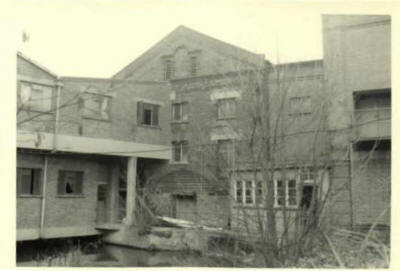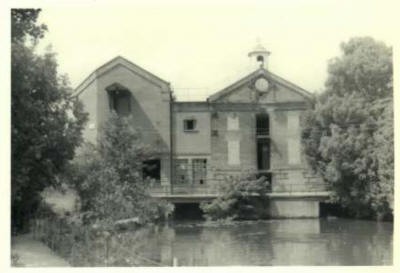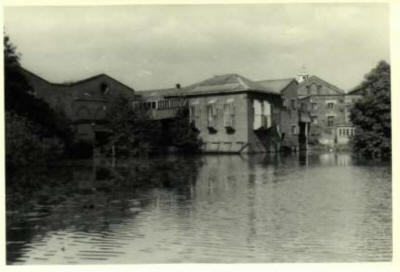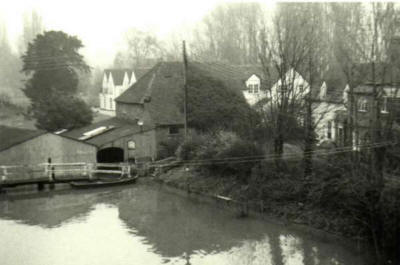|
   |
|
Page 3 |
Newsletter 136 Spring 2022 © Hampshire Mills Group |
|
Bisham Temple Mills
A brief history by
Sheila Viner
Photographs are shown by kind permission of Brian
Boulter
|
|
Ask
most people what they know about
the River Thames and you are likely to get three
considered replies:
1. London’s Docklands;
2. The scandalous parties at
Cliveden in the 1960s; and
3. Henley is on it and has
an annual Regatta.
Well, let me add that Nelson’s
fighting ships were fitted with copper processed in
a mill sited in the middle of the River Thames near
an abbey where Crusading Knights once honed their
battle skills and now where national and
international athletes train.
The heavily industrial three
Temple Mills at Bisham milled, hammered, and
manufactured domestic wares, construction industry
and marine items throughout several centuries
utilising the power of a particular area of the
River Thames. Today, it is a quiet island of
expensive, gated housing.
|
|

Bisham Temple Mills from the air about 1960
following a fire in the paper mill
|
|
Temple Mill Island is in the
River Thames, upstream of Marlow and just downstream
of Temple Lock. Bisham is on the Berkshire bank
close to Hurley which had its own working watermill
producing paper alongside Hurley Lock.
The area name is derived from
the time that the Knights Templar inhabited Bisham
Abbey where monks had operated a corn mill. It is
possible that the river also powered a forge for
making or honing swords and/or chain mail
production. These days it is named after the three
watermills that used to be on Temple Island; it
once boasted of having the largest waterwheel on the
entire River Thames.
In
around 1710 it was engaged in the heavier industrial
use of a copper foundry. Ten years later Daniel
Defoe passed through the Marlow area on his travels
and referred to the mills in his A tour thro’ the
Whole Island of Great Britain (1724-1727):
“…three very remarkable mills,
called Temple Mills, for making Bisham Abbey
Batterie-work viz. Brass Kettles and Pans &c of all
sorts. And these works were attended with no small
success, till in the year 1720, they made a bubble
of it; and then it ran the fate of all the ‘Bubbles’
at that time.”
And, of course, he called it
BISHAM ABBEY BATTERIE WORKS because of the
continuous metal bashing noise which could be heard
over a wide area as the hammerings echoed around the
valley.
|

Mill 1,
'The Old Copper Mill',
with subsequent additions
|

Mill 1,
Head Elevation
|

Mill 1,
Tail Elevation |
|
The Upper Bank works were initially used in the
production of lead and zinc, but in 1782 ownership
was transferred to Thomas Williams who converted it
to copper smelting and operated it on behalf of the
Parys Mine Company. Ore was mainly obtained from
Cornwall, purchased by his Cornish Agent, John
Vivian.
Thomas Williams of Llanidan was the entrepreneurial
new owner of Temple Mills by 1788, which created a
complete cycle of raw commodity to finished product
by shipping the mined ore around the coast from
Cornwall to his smelting works in South Wales, then
transporting the smelted copper by trow from Swansea
to Brimpton Port in Gloucester, from where it was
transferred to a Thames barge and completing its
journey to Bisham via the newly opened Thames &
Severn Canal. Besides producing domestic ware, such
as Defoe reported, the foundry hammered out copper
sheathing for the hulls of wooden sailing ships,
plus the necessary bolts and nails for fixings.
Vessels bearing copper panels were saved from wood
boring by marine worms, clinging seaweeds, and other
potentially hazardous marine life.
Mr Williams, known as ‘The Copper King’ became
elected Member of Parliament for Great Marlow in
1790, maintaining his seat until his death in 1802.
He meanwhile had a mansion built, Temple House,
suitable for entertaining. It is said, however,
that Queen Victoria was very unhappy about the way
that the Williams family at Temple House aided the
louche life style of the then Prince of Wales, the
future Edward VII. He is reported both to have had
an affair with one of the Williams family’s
daughters, the Countess of Aylesford, and to have
brought a favourite mistress, Lillie Langtry, to
Temple House.
The works were transferred in 1802 to his son, Owen
Williams, a long-time associate of Pascoe Grenfell
and Grenfell’s brother, William. Trading as
Williams Grenfell & Company, this firm, in various
guises, continued to smelt copper at these works
into the twentieth century. The Grenfell family
owned the Taplow Estate, between Cliveden and
Maidenhead.
|
|

Mills
3, 2, and 1 from the mill pond
|

Downstream view from Mill 1 |
|
In 1848 T Weedon & Sons took over the site, altering
at least one of the mills to manufacture brown
paper, a common practice in our local mills as the
water was not pure enough to produce white paper
such as for bank notes. Paper and board making
continued for several decades but what must have
been an exciting, or certainly interesting, period
took place during WW2 when papermill workers from
Earlsfield were moved to the Bisham area and some of
the Temple Mills machinery was adapted to carry out,
in secret, the latest innovation for faster
communication – ticker-tape.
After the war the site was used for waste paper
storage and a brand new utility, Pitch Fibre Pipes,
traded as Temple Tubes and used wholesale by the
construction industry but which, as I can vouch, is
not a good long term product for waste water piping
in a very heavy clay area.
Closed in 1969, a fire swept through the old Bisham
Temple Mills paper mill site. It was eventually
sold to developers for superior housing with no sign
of the industrial times.
For a detailed history and description of Bisham
Temple Mills see the survey carried out by Brian
Boulter and David G Wilson shortly before the site
was demolished. My grateful thanks to them plus
retired Temple Mills paper mill workers Robin Ellis
Cooper and Frank Beard for allowing me to use their
material and memories.
|
|
|
